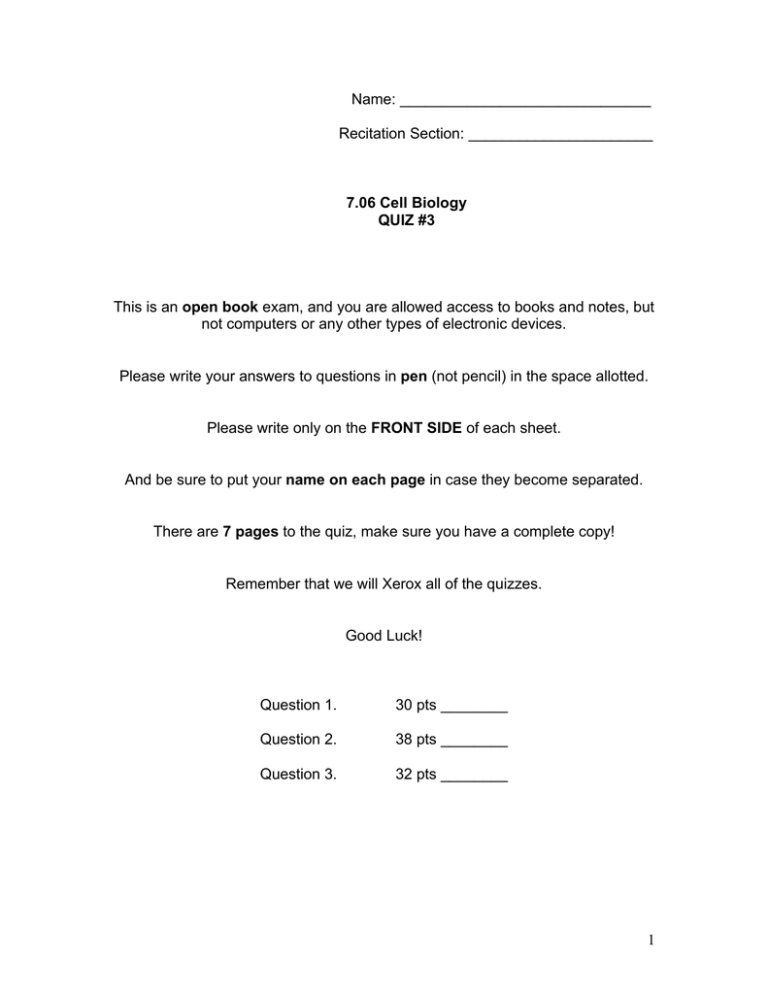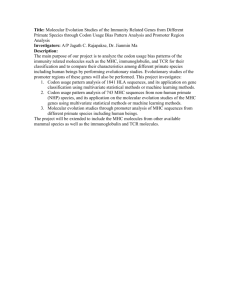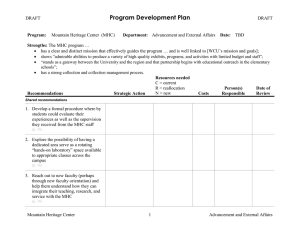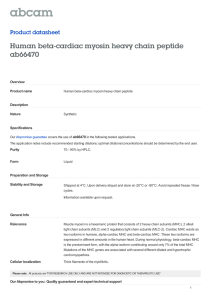Name: ______________________________ Recitation Section: ______________________ open book
advertisement

Name: ______________________________ Recitation Section: ______________________ 7.06 Cell Biology QUIZ #3 This is an open book exam, and you are allowed access to books and notes, but not computers or any other types of electronic devices. Please write your answers to questions in pen (not pencil) in the space allotted. Please write only on the FRONT SIDE of each sheet. And be sure to put your name on each page in case they become separated. There are 7 pages to the quiz, make sure you have a complete copy! Remember that we will Xerox all of the quizzes. Good Luck! Question 1. 30 pts ________ Question 2. 38 pts ________ Question 3. 32 pts ________ 1 Question 1 (30 points) Name: ______________________________ A (4 points). You are given two separate cDNAs, each of which encodes a glycoprotein of similar size. One of the cDNAs encodes a protein (protein A) known to reside in lysosomes, the other encodes a protein (protein B) that is expressed at the cell surface. What tools would you use to distinguish between the localization of the two proteins (you may genetically modify each of the two cDNAs)? B (4 points). If you were given the nucleotide sequence of the two cDNAs, what type of sequence elements would you be looking for that would indicate that you are dealing with: i) a secretory protein ii) a membrane protein iii) a type I versus a type II membrane protein iv) a glycoprotein C (8 points). You are allowed to make mutations in the cDNAs that were given to you. What kind of mutation would you introduce, and what is the expected outcome you are looking for to verify your answers given in part B. 2 Name: ______________________________ D (8 points). Having identified each of these cDNAs, you want to determine the intracellular route traveled by each of these glycoproteins, and the speed with which they traverse their biosynthetic pathways to arrive at their final destination. How would you use a pulse-chase experiment in combination with monitoring the glycosylation status of your glycoproteins to determine the speed with which these proteins traverse their biosynthetic pathway? E (6 points). The drug brefeldin A blocks transport of proteins from the ER to the Golgi (anterograde transport), but not Golgi-to-ER trafficking (retrograde transport). What are possible targets of this drug? 3 Question 2 (38 points) Name: ______________________________ A. (5 points) Briefly describe the 5 mechanisms (or processes) by which antibody diversity is generated. B. (4 points) Successfully rearranged immunoglobulin heavy chains in B-cells rarely contain multiple D segments. Why not? If you’d like, you can use a diagram to illustrate your brief explanation. C. (2 points) A new species of iguana is discovered the B cells of which contain immunoglobulin heavy chain sequences demonstrating D-D fusions. Its recombination machinery is identical to that of humans. What might be different about the organization of this animal’s immunoglobulin heavy chain locus? 4 Name: ______________________________ D. (8points) Briefly describe the structure of the B-cell receptor in the various stages of B cell development. How would the deletion of the exons encoding the transmembrane segment of the μ chain affect the final outcome of B cell development? E. (6points) The choice between the production of an mRNA that encodes secreted or membrane-bound IgM is determined by the choice of poly-A addition sites. If the proximal poly-A addition site (gray circle in the diagram below) is deleted by gene targeting, what kind of antibodies, if any, would you expect to be circulating in this mouse? Explain your answer. Constant region domains V D J Cμ1 Cμ2 Cμ3 Transmembrane domains Cμ4 Poly-A sites 5 F. (4points) The phenomenon of MHC restriction accounts for the failure of T cells from an individual with one type of MHC products to respond to stimulation by an antigen- presenting cell from an individual with a different type of MHC products. What are the structural features that distinguish the MHC products in the two individuals, and how do these features account for MHC restriction? 6 Name: ______________________________ G. (6points) You are screening mice with mutations in the interleukin-4 (IL-4) signaling pathway. You discover a mouse that has a mutation in the STAT6 transcription factor. STAT6 in these mice is transcribed, folded correctly, and maintained in the cells at normal levels; however, T cells of these mutant mice are unresponsive to IL-4. Propose 2 possible mutations in STAT6 that would account for this exact phenotype, and briefly explain them. H. (3points) Through the screen described in part G, you discover another mutant mouse, in which IL-4-mediated signaling, once initiated, persists and is not attenuated with time. Propose a mutation that would result in this phenotype. 7 Question 3 (35 points) Name: ______________________________ A (2 points). What is the concentration of ligand required to obtain a fractional occupancy of 10% for a receptor that binds this ligand with a Kd value of 10e-9 M? B (6 points). In order to block internalization of a receptor from the cell surface, you decide to use a mutant form of the GTPase dynamin. What kind of mutation would lead to blockage of internalization without affecting dynamin levels? Is there a pharmacological trick that you could use to achieve the same effect? C (6 points). The efficiency of bacterial phagocytosis by macrophages is enhanced by the presence of antibodies. What portion of the antibody is most likely involved in binding to specific receptors on macrophages and how would you verify this suggestion experimentally? 8 Name: ______________________________ E (6 points). You have discovered that the natural product lactacystin is a potent inhibitor of proteasomal proteolysis. When you apply this compound to cells that express the receptor for interleukin-1, you find that the action of interleukin-1 is reduced. The cell line you use for these experiments expresses the enzyme luciferase under the control of an NFkB sensitive promoter. You determine the output of the interleukin-1 pathway by monitoring luciferase activity. Explain this result. F (6 points). Explain how phosphorylation of proteins that are not themselves enzymes can control full and rapid (within minutes) activation of kinases that are part of a signal transduction cascade. Provide 2 examples. G (6 points). Many signal transduction cascades culminate in the activation of transcription of a select set of target genes. Such events are controlled by the delivery of transcription factors to their proper destination. The immunosuppressant cyclosporin prevents activation of transcription of T cell specific genes. Explain its mechanism of action. 9






